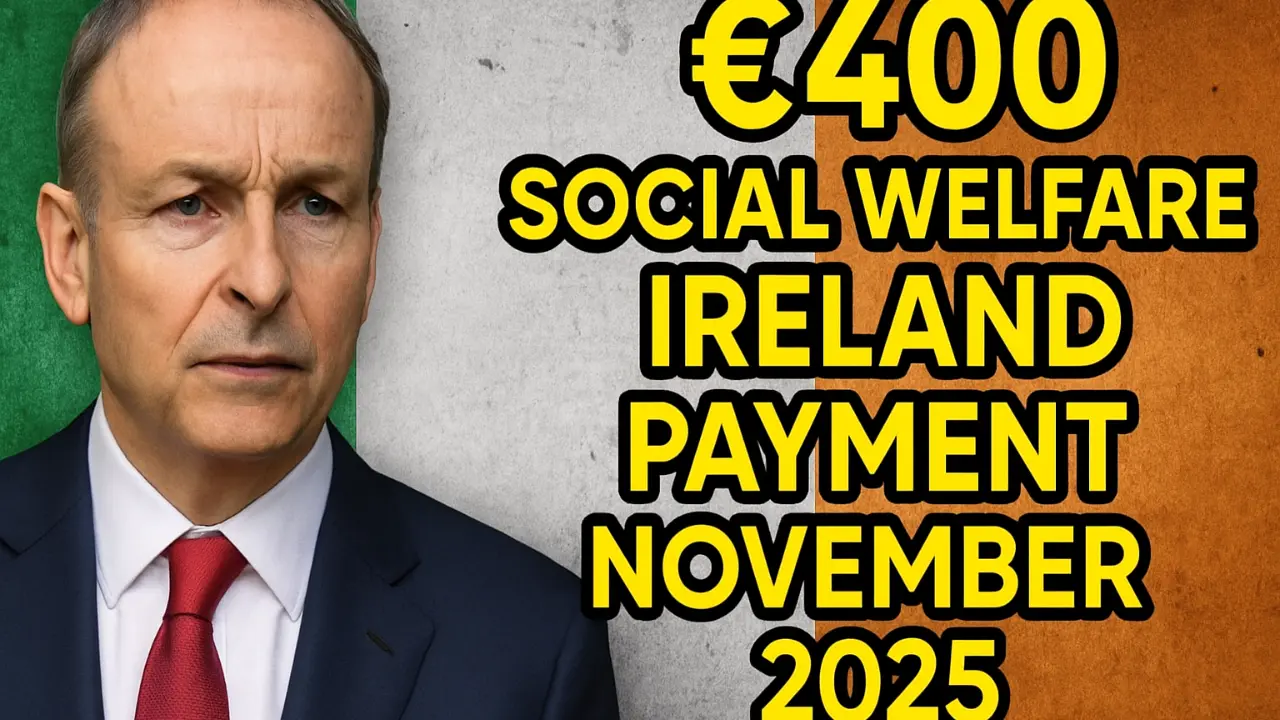Ireland’s social protection system is undergoing one of its most closely watched updates of the year, and the announcement of a €400 social welfare payment has triggered widespread attention among households, workers, pensioners, and low-income families. Designed as a targeted support measure to offset rising living costs, energy expenses, and inflation pressures, the €400 payment marks another strategic effort by the Irish government to shield vulnerable groups from the ongoing financial strain facing millions across the country.
This payment reflects a broader governmental commitment to income support adjustments, cost-of-living interventions, and welfare bonus packages that have been rolled out over the past two years. As inflation slowly stabilises and energy pressures begin to ease, many households are still feeling the burden of global supply disruptions, increased rent prices, and the lingering financial complexities brought on by the economic downturn.
In this extensive guide, we break down everything the public needs to know about the €400 social welfare payment: eligibility, payment schedules, how to apply, who benefits, government intentions, economic impact, and how this measure fits within the bigger social protection landscape.
Overview of the €400 Social Welfare Payment
According to galwaybeo, The €400 payment forms part of a broader cost-of-living package initiated by the Department of Social Protection. This payment aims to support:
-
Low-income households
-
Pensioners
-
Carers and people with disabilities
-
Long-term welfare claimants
-
Working families receiving supplementary payments
It is structured as a one-time lump-sum payment, intended to offer immediate relief rather than recurring financial support.
Key Features of the €400 Payment
-
One-time, tax-free payment
-
Automatically issued to eligible welfare recipients (no separate form unless otherwise stated)
-
Designed as an anti-inflation and energy-support measure
-
Paid directly into bank accounts or via post office collection
-
Expected to support more than 820,000 individuals across Ireland
Purpose Behind the €400 Payment
The government introduced this payment after conducting economic surveys that showed many households were continuing to struggle despite wage growth and stabilising energy prices. Key issues included:
-
High rental prices in counties Dublin, Louth, Limerick, Galway, and Cork
-
Increased grocery costs (up by approx. 7% year-on-year)
-
Transport cost increases due to fuel fluctuations
-
Energy bills still remaining above pre-pandemic levels
-
Rising healthcare and insurance premiums
The payment is intended to deliver short-term breathing space for financially vulnerable groups.
Who Qualifies for the €400 Payment?
Eligibility for the €400 payment is tied to specific social protection schemes. Those receiving long-term welfare benefits are prioritised. The government established several categories of eligible recipients including:
Eligible Groups
-
People receiving Jobseeker’s Allowance or Jobseeker’s Benefit
-
Pensioners receiving State Pension (Contributory or Non-Contributory)
-
Carers receiving Carer’s Allowance or Carer’s Benefit
-
People with disabilities receiving Disability Allowance, Blind Pension, or Invalidity Pension
-
Long-term illness or injury benefit recipients
-
Lone parents receiving One-Parent Family Payment
-
Low-income workers receiving Working Family Payment
-
Individuals receiving Supplementary Welfare Allowance
-
Recipients of Fuel Allowance, given higher winter cost burdens
The government has stated that no additional documentation is required for most beneficiaries; payments will be automated.
Payment Breakdown and Scheme-Wise Eligibility
To simplify understanding, here is a table outlining eligibility across various welfare categories.
€400 Payment Eligibility Overview
| Category / Welfare Scheme | Eligible for €400 Payment | Notes |
|---|---|---|
| State Pension (Contributory & Non-Contributory) | Yes | Automatically issued |
| Disability Allowance | Yes | No application required |
| Carer’s Allowance / Benefit | Yes | Full and half-rate eligible |
| Jobseeker’s Allowance | Yes | Long-term claimants prioritised |
| Jobseeker’s Benefit | Yes | Subject to qualifying criteria |
| One-Parent Family Payment | Yes | Automatic payment |
| Working Family Payment | Yes | Income-tested but auto-eligible |
| Supplementary Welfare Allowance | Yes | Full eligibility |
| Fuel Allowance Recipients | Yes | Higher energy-support focus |
| Back to Work Enterprise Allowance | No | Not eligible unless receiving another qualifying payment |
| Student Grants (SUSI) | No | Not linked to welfare mechanism |
How Many People Will Receive the €400 Payment?
According to internal social protection estimates, the number of individuals eligible for this payment is expected to exceed 820,000, broken down approximately as:
-
420,000 pensioners
-
200,000 disability and illness benefit recipients
-
95,000 carers
-
75,000 working family payment recipients
-
30,000 lone parents
This makes the payment one of the largest cost-of-living lump sums rolled out by the Irish government since 2022.
Payment Schedule: When Will €400 Be Paid?
The Department of Social Protection plans to release the €400 payment in phases, ensuring that each welfare category receives funds based on existing payment cycles.
Expected Payment Timeline
-
Payments expected from late November through early December
-
Pensioners & disability recipients usually paid first
-
Carers and working family payment recipients follow
-
The final batch includes jobseekers and supplementary welfare recipients
Most recipients will receive the payment automatically, coinciding with their scheduled weekly or monthly deposit dates.
No Application Needed: Automatic Payment System
A major advantage of this assistance is the automatic eligibility verification conducted through the Department of Social Protection database. This avoids lengthy forms, delays, or manual confirmations.
Only those with outdated bank details or individuals whose welfare status recently changed may need to update personal information through:
-
MyWelfare.ie
-
Local Intreo Centre or Social Welfare Office
-
Post Office verification (for collection recipients)
Why Ireland Needed This €400 Support
While Ireland’s economy has shown resilience with strong employment numbers and growing foreign investments, the cost-of-living crisis has left a disproportionate impact on vulnerable groups.
Key Economic Factors Influencing the Payment
-
Inflation peaked at over 9% in recent years
-
Average rent for a two-bedroom apartment in Dublin exceeds €2,100 per month
-
Grocery prices increased by nearly €780 per household annually
-
Energy bills increased over 40% above pre-pandemic levels
-
Healthcare premiums and car insurance continue rising
The €400 payment serves as a targeted relief mechanism to offset these financial pressures.
Impact on Pensioners
Pensioners remain one of the highest-priority groups in Ireland’s welfare structure. The €400 payment will:
-
Offset increased heating and medical costs
-
Support pensioners whose incomes do not keep pace with inflation
-
Provide relief during the winter months, especially for those living alone
The government estimates that 420,000+ pensioners will receive this payment, making them the largest beneficiary group.
Impact on Carers
Carers, who often rely on limited income support while managing full-time caregiving roles, are also included.
Benefits for Carers
-
Recognises the unpaid work of over 100,000 informal carers
-
Helps cover higher household utility use
-
Acknowledges rising medical support costs
This payment aligns with broader efforts to financially assist Ireland’s caregiver community.
Impact on People with Disabilities
People with disabilities face ongoing financial challenges due to health-related expenses, mobility needs, and energy consumption requirements. The €400 payment aims to:
-
Reduce financial stress
-
Help with transportation costs
-
Offset higher medical and equipment expenses
The disability community forms the second-largest group of beneficiaries after pensioners.
Impact on Low-Income Workers
One of the most significant additions is the inclusion of Working Family Payment recipients. These are families that do work but remain below income thresholds.
Why They’re Included
-
Increased childcare costs
-
Rising food and transport expenses
-
Wage growth not keeping pace with cost of living
Their inclusion highlights the government’s shift toward supporting working poor households, not only long-term welfare recipients.
Geographic Distribution: Which Counties Benefit Most?
The distribution of welfare recipients varies by region. Counties with higher concentrations of pensioners, renters, and low-income households will receive the highest number of payments.
Table: Estimated County-Wise Beneficiary Distribution
| County | Estimated Recipients | Key Notes |
|---|---|---|
| Dublin | 185,000 | Highest due to population size |
| Cork | 78,000 | Large pensioner base |
| Galway | 46,000 | Student-heavy population but high WFP usage |
| Limerick | 41,000 | Strong support for carers and disability claimants |
| Donegal | 39,000 | High rural welfare dependency |
| Mayo | 35,000 | Significant pension-age population |
Government Budget Allocation
The €400 payment is part of a larger cost-of-living support package.
Budget Breakdown
-
Total budget allocated: Over €320 million
-
Distribution channels:
-
€160 million for pensioners
-
€80 million for people with disabilities
-
€45 million for carers
-
€30 million for working family payment recipients
-
€14 million for lone parents and supplementary welfare recipients
-
This budget is combined with energy credits, rent tax credits, and welfare rate increases introduced during the annual budget cycle.
Comparison to Previous Welfare Bonuses
Ireland has launched several bonus payments since 2022 to help households navigate inflation. The €400 payment is considered mid-range in comparison.
Table: Comparison of Key Welfare Bonus Payments (2022–2025)
| Year | Payment Amount | Target Group | Notes |
|---|---|---|---|
| 2022 | €200 | Fuel Allowance Recipients | Winter assistance |
| 2023 | €400 | Working Family Payment Recipients | First major cost-of-living boost |
| 2024 | €250 | Disability Recipients | Summer bonus |
| 2025 | €400 | Multiple Groups | Broadest eligibility |
How to Check Eligibility
Although payments are automatic, individuals can confirm eligibility through several platforms:
Steps
-
Log into MyWelfare.ie
-
Navigate to “Payment Information”
-
Check recent welfare updates
-
Ensure bank details are correct
-
Contact Intreo Centre if payment does not appear within expected time
Phone support is also available for pensioners or those lacking online access.
Potential Issues and Delays
A small percentage of recipients may experience delays due to:
-
Bank detail mismatches
-
Change of address
-
Document verification issues
-
Recent transitions between welfare schemes
Officials state that over 98% of payments will process on time.
Public Response and Reception
Public response to the €400 payment has been largely positive, with households expressing relief about the extra support ahead of winter months. However, some advocacy groups argue the payment is insufficient compared to rising costs.
Common Public Arguments
-
Payment provides short-term relief
-
More long-term welfare reforms are needed
-
Rent and food inflation reduce impact
-
Pensioners welcome the increase but caution that energy prices remain unpredictable
Impact on the Irish Economy
Although welfare payments are social interventions, they also stimulate the economy.
Expected Economic Effects
-
Increased consumer spending
-
Boost to local businesses
-
Stabilisation of low-income households
-
Reduced dependence on credit borrowing
-
Strengthened winter economic activity
Economists note that while lump-sum payments are not permanent solutions, they help prevent economic stagnation during vulnerable periods.
Government’s Future Social Welfare Plans
The €400 payment is one step within a broader multi-year welfare strategy that includes:
-
Planned increases to core welfare rates
-
Continued energy credit support if needed
-
Enhanced supports for disability and carer communities
-
Reforms to Working Family Payment thresholds
-
Long-term pension sustainability discussions
The government’s goal is to create a more resilient social support structure.
Frequently Asked Questions (FAQ)
Will everyone receiving welfare get €400?
No, only eligible categories listed above.
Do I need to apply?
No, the payment is automatic.
Is the payment taxable?
No, it is a tax-free lump sum.
What if my payment doesn’t arrive?
Contact Intreo or use MyWelfare.ie to check pending issues.
Final Thoughts
The €400 Social Welfare Ireland payment arrives at a crucial moment for many households, pensioners, carers, and people with disabilities. As inflation continues to impact everyday life, this financial support serves as both an economic booster and a social safety measure. While it is not a permanent fix to long-term affordability issues, it provides immediate relief and demonstrates ongoing governmental commitment to supporting vulnerable citizens.
For thousands of families, this payment means more stability, more breathing room, and a chance to navigate the winter months with a little less financial stress. Ireland’s broader welfare policies will continue to evolve, but for now, the €400 payment stands as one of the year’s most impactful social support measures.







Leave a Comment